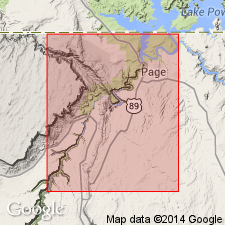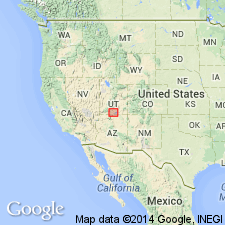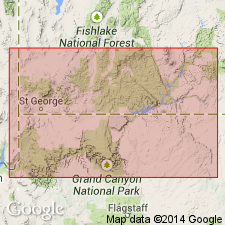
- Usage in publication:
-
- Thousand Pockets tongue*
- Modifications:
-
- Named
- Dominant lithology:
-
- Sandstone
- AAPG geologic province:
-
- Plateau sedimentary province
Summary:
Named as a tongue of the Navajo sandstone of the Glen Canyon group. Named for Thousand Pockets about 2 1/2 mi north of and parallel to Glen Canyon. Type section is on north side of Judd Hollow, NW1/4 sec 31, T43S, R2E, Kane Co, UT in the Plateau sedimentary province. Consists of gray to white to red-brown, fine-grained to very fine grained, quartzose, silty, tangentially cross-bedded sandstone 228 ft thick at type where it overlies Judd Hollow tongue (new) of Carmel formation and underlies the main body of the Carmel. Other sections measured at Catstairs and Adairville where tongue is 228 ft and 252 ft thick, respectively. Mapped at northwest corner of geologic map at Cedar Mountain, Coconino Co, AZ. Columnar section. Assigned a Jurassic and Jurassic? age.
Source: GNU records (USGS DDS-6; Denver GNULEX).

- Usage in publication:
-
- Thousand Pockets Tongue
- Modifications:
-
- Contact revised
- AAPG geologic province:
-
- Plateau sedimentary province
Summary:
Upper contact revised in that Thousand Pockets Tongue of Navajo Sandstone of Glen Canyon Group underlies the newly named Paria River Member of the Carmel Formation of San Rafael Group in Kane Co, UT in the Plateau sedimentary province. Unconformably overlies Judd Hollow Tongue of Carmel. Thins gradually west and is replaced by the Judd Hollow. Traced as far west as Skutumpah Creek, Kane Co. Cross section. Block diagram. Jurassic age.
Source: GNU records (USGS DDS-6; Denver GNULEX).

- Usage in publication:
-
- Thousand Pockets Tongue*
- Modifications:
-
- Revised
- Areal extent
- AAPG geologic province:
-
- Plateau sedimentary province
- Paradox basin
Summary:
Formerly a tongue of Navajo Sandstone, Glen Canyon Group. Reassigned as a tongue of Page Sandstone (new) of San Rafael Group. Is a cliff-forming, cross-bedded sandstone present only in south-central UT--from near Cannonville, Kane Co, Plateau sedimentary province east to Early Weed Bench, Garfield Co, Paradox basin. Up to 76.8 m thick. Interfingers with banded member of Carmel Formation. Overlies Judd Hollow Tongue (formerly of Navajo Sandstone), limestone or banded member of Carmel Formation. Underlies gypsiferous or upper member of Carmel. Correlates with Boundary Ridge Member of Twin Creek Limestone in WY and UT. Of early and middle Bathonian, Middle Jurassic age. Correlation chart. Cross sections. Measured section.
Source: GNU records (USGS DDS-6; Denver GNULEX).
For more information, please contact Nancy Stamm, Geologic Names Committee Secretary.
Asterisk (*) indicates published by U.S. Geological Survey authors.
"No current usage" (†) implies that a name has been abandoned or has fallen into disuse. Former usage and, if known, replacement name given in parentheses ( ).
Slash (/) indicates name conflicts with nomenclatural guidelines (CSN, 1933; ACSN, 1961, 1970; NACSN, 1983, 2005, 2021). May be explained within brackets ([ ]).

